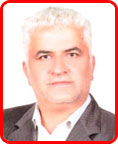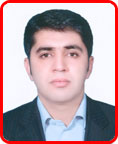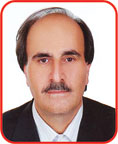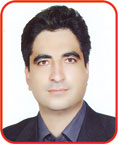

Agents
|
Keyvan Kasehfi Position : Chairman Phone : +988338228131 and +988338228141 E - mail : k_kashefi@ krccima.ir |
 |
Holder of Political Sciences BSc. degree chairman of Kermanshah Chamber of Commerce for two terms chairman of the Kermanshah Chamber of Guilds for ten years secretary of the country’s Chamber of Guilds for four years. |
|
Nelson Hazrati First Vice President Phone : +988338228131 and +988338228141 E - mail : n.hazrati@ krccima.ir |
 |
Managing director of Kermanshah Municipality Collaboration Organization Kermanshah dist.4 mayor General Secretary of Kermanshah Chamber of Commerce |
|
Jamshid Rostami Second Vice Chairman Phone +988338228131 and +988338228141 E - mail : j.rostami@ krccima.ir |
 |
Member of the sixth and seventh terms of council of representatives of Kermanshah Chamber Exemplary exporter for eight years Asim Tejarat Gharb Co. managing director |
|
Abdollah Sokhansanj Treasurer Phone : +988338228131 and +988338228141 E - mail : a.sokhansanj@ krccima.ir |
 |
Member of the of Kermanshah Chamber representatives, for 5 consecutive terms Gharb Plast Co. and Gharb Plasco Co. managing director Veteran industry craftsman |
|
Babak Torabi The clerk Phone :+988338228131 and +988338228141 E - mail : b.torabi@ krccima.ir |
 |
Member of the board of directors and treasurer of the marketing society of Iran Chamber of Commerce The managing director of staff to help prisoners of the province Farashir Paknam Co. managing director |
|
Mohammadaref Ebrahimi Member of the board of representatives Phone : +988338228131 and +988338228141 E - mail : m.ebrahimi@ krccima.ir |
 |
President of Kermanshah House of Mine Vice - president of Kermanshah Chamber of Commerce for 2 terms Seven years exemplary mine owner in the province |
|
Ebrahim Omidi Member of the board of representatives Phone : +988338228131 and +988338228141 E - mail : e.omidi@ krccima.ir |
 |
Member of Kermanshah Chamber council of representatives, in 7th period Abadan Palayesh Alborz Co. managing director Exemplary unit for standard, industry and export in the province |
|
Gholamreza Amiri Member of the board of representatives Phone : +988338228131 and +988338228141 E - mail : gh.amiri@ krccima.ir |
 |
Representative, vice - president, and speaker for the people in the 1st, 2nd, and 3rd periods of Kermanshah City Islamic Council Founder of Novin foreign language school |
|
Shahriar bavandpour Chleh Member of the board of representatives Phone : +988338228131 and +988338228141 E - mail : sh.bavandpour@ krccima.ir |
 |
Founder and managing director of chickpea cultivators cooperative 2073 since 2001 Three terms member of the board of directors of Kermanshah live cattle exporters union Founder and board member of Iran National Chickpea Council |
|
Borhan Heidari Member of the board of representatives Phone : +988338228131 and +988338228141 E - mail : b.heidari@ krccima.ir |
 |
Vice - President of the Iran National Chickpea Council Kermanshah Chamber Trade Commission consultant Member of Organic Society, and Livestock Exporters Union |
|
Ebrahim Khamisi Member of the Board of representatives Phone : +988338228131 and +988338228141 E - mail : e.khamisi@ krccima.ir |
 |
Member of Kermanshah Chamber council of representatives for 3 consecutive terms Fanarsazi Gharb Co. managing director Member of Iran - Iraq Joint Chamber |
|
Abdolreza Zardoee Member of the Board of representatives Phone : +988338228131 and +988338228141 E - mail : a.zardoee@ krccima.ir |
 |
Over 40 years business experience Vice - President and member of the board of directors of the 5th and 6th period of Kermanshah Chamber Member of the joint Iran - Iraq room |
|
Reza Salim Sasani Member of the board of representatives Phone : +988338228131 and +988338228141 E - mail : r.sasani@ krccima.ir |
 |
Kermanshah International Exhibition managing director President of the Kermanshah Chamber of Guilds Vice - president Kermanshah Chamber of Commerce |
|
Heydar Kadivar Member of the board of representatives Phone : +988338253482 E - mail : h.kadivar@ krccima.ir |
 |
Country’s West Wheat Farmers Co. managing director Membership for 2 terms in Kermanshah & Iran Chamber council of representatives Model Farmer for many consecutive terms Member of Iran Chamber Commission of Agriculture |
|
Naser Morady Member of the board of representatives Phone : +988338228131 and +988338228141 E - mail : This email address is being protected from spambots. You need JavaScript enabled to view it. |
 |
Member of the council of representatives, and chairman of trade commission of Kermanshah Chamber President of the Iran National Chickpea Council Chairman of the cereals sellers guild of the province President of Kia Arg System Co. Secretary of Kermanshah Province Association of Entrepreneurs |
About Kermanshah
Kermanshah through the Passage of Time
The historical province of Kermanshah, like other parts of our ancient country, has preserved relics of the eras of greatness of Iran in the midst of its mountains and Plains.
Unlike other parts of Iran that have become provisional habitats, this province has always been occupied without interruption through different periods of the history. The archaeological evidence show that the region had been one of the first habitats of early humans and one of the most important centers of population in the Central Zagros Mountains. All human life stages and periods ranging from stone age to pre-historic civilizations and to large government formation have followed their course in these boundaries.
Such that the Bistoon Hunters Cave reveals interesting points about the history of human life in Paleolithic era in Iran. Thereafter, about 9 thousand years ago due to warming climate, humans left the cave and settled at one place and that development, resulted in agriculture, animal husbandry, and consequently, village life. Undoubtedly the first villages have formed in this province such as Ganjdare Hersin, Gakieh, and Tapesarab. Prehistoric men of Ganjdare, were among the first who invented pottery in Iran and were inclined towards industrial activities.
In the fourth millennium B.C., Kermanshah Province was one of the most important commercial centers and its merchants and businessmen traded and exchanged goods with Shush and Mesopotamia merchants.The presence of Bazaars in Kangavar’s Goodin and Islamabad’s Chghagavaneh that are reminder of those times, are proof of this claim.
Based on Babylonian / Assyrian tablets, inhabitants of Zagros were Lulube and Gothic tribes.
These vigilant and brave men, in order to protect this land, have always been at war with Mesopotamians and have been victorious too, and since then the Valleys of Zagros have been center of Iranian / Mesopotamian civilizations for centuries and eventually the Iranian element dominate the area with its civilization. The existence of reliefs by these tribes in Sarpolzahab affirms this, which is one of the oldest in the Middle East.
Kermanshah area, due to common borders with Assyria, was continuously exposed to invasion of powerful government of Assyria and kings such as Tiklat-Pal-Isri, Shalmaneser V, have invaded Kermanshah boundaries frequently. The tablets remaining from Assyrian times, mention realms like Parswa, Zakruti, Madiha, and Nishani. Nishani was a region covering modern Mahidasht and Kermanshah, which were famous for their horse breeding and keeping pastures. Assyrian Yearbooks mention a city called Elipee that historians have pinpointed it between Hamadan and Kermanshah and some other historians have located it in the current site of Kermanshah.
With the formation of the states, this realm had also become one of the Medians centers and valuable relics like Goodin Fortress has remained from that era.
In that period Kermanshah was one of the vital Iranian highways and the road from Ekbatan to Babylon passed through this province.
In Achaemenes period, a royal road that connected Ekbatan to Babylon, added to the prosperity of the region. After the extinction of Achaemenes, during Solouki era, parts of Kermanshah like Bistoon and Dinor accommodated Greek colonies but soon Parthians defeated them and settled in the region. Parthians’ reliefs in Bistoon are witness to this development. In that period, Bistoon was a major centers of Parthian age.
In the course of Sassanid period, Kermanshah Province was more prosperous than any of the other ages. This region has always been of interest to Sassanid kings and due to proximity to Tisfon, their capital; they spent the summer in summer resorts around the province. Islamic historians have frequently mentioned that Khosro I had built several palaces around Taq Bostan and had hosted kings like Chinese Emperor, Indian king, Roman Cesar, etc.
By construction of cities such as Halvan in this side, and the city building policies of Sassanid kings at the country’s west side that led to foundation of Kermanshah, this region gained more credit and Sassanid kings, by constructing bridges on the rivers and public places, brought about welfare and economic prosperity for the people of the region.
With the defeat of the Sassanid by Muslims, the people of this region, unlike some other areas, were among the first communities that accepted the holy religion of Islam and started to promote it.
Abdullah Bin Omar Mosque in Rijab is one of the oldest early Islamic mosques and its is a reminder of that era. Tombs of faithful companions of the Prophet that helped him in wars like Abudajane are in Rijab. In Abbasid regime, Kermanshah was one of the four major cities of Jebal States. Harunolrashid, the famous Abbasid Caliph was especially concerned about this, as a result, tourists have mentioned the beauty and prosperity of the city.
Ibn Hoghl and Estakhri describe Kermanshah as a beautiful township with abundant water and trees. Moghadasi included this city along with Hamadan, Ray, and Isfahan in the list of 4 famous cities of Jebal State.
In the third century Hegira, Kermanshah was inside Safarian government territory. In the 4th century, a small Kurdish dynasty called Hasnoyeh gained independence in western states. The founder of this dynasty was and its most famous figure, ruled for nearly fifty years, and choose the big Sarmaj Castle as the seat of his government. In 441, Sultan Toghrol The Seljuk, sent a 100 thousand strong army and after 4 years conquered the castle.
In the sixth century, Sultan Sanjar The Seljuk, put Kermanshah and its surroundings under the rule of his nephew, Sloeiman Shah aka. Yve.
In the seventh century, Kermanshah, like Khorasan and other areas of Iran, was heavily damaged by Mongol invasion of Iran, such that Holaco’s troops committed tragic murder and looting in this area, but at the end of Ilkhani era, in Abusaid government, this area is again a matter of concern such that during his reign, the city of Sultanieh Chamchamal was built near the Bistoon. At that time, as Hamdollah Mostoufi noted, Kermanshahan was one of the 16 states of Kurdistan.
In the 9th century and early 10th century, Ottoman Turks invaded Kermanshah. In that time, Hercin and Mahidasht were emirates but there is no sign of Kermanshahan.
At the time of the Saffavids, Kermanshahan enjoyed importance and prestige. In the period of the reign of Shah Tahmasb I, a government called Kalhor, and in Shah Safi’s period, a government called Songhor & Kalhor was established in the region and were transferred to Zangeneh Lords (Khans). In fact, this is the time of the re-organization of Kermanshah and the beginning of the formation of the current Kermanshah Province.
Concurrent with the Afghan attack and the fall of Isfahan, Kermanshahan faced Ottoman aggression again and once again started to become a ruin. In the Zand era, the Zangeneh Lords (Khans) and Kermanshah residents, did not accept the Karim Khan rule at first, therefore Kermanshah faced siege and destruction for a while. During the rule of Qajar dynasty, Kermanshah was deemed important. Fathali Shah, in 1221 Lunar Hegira Calendar, appointed one of his sons called Mohammad Ali Mirzaye Dolatshah to this position as Iraq borderline keeper and also annexed the Khuzestan State to his territory and in fact, in this time, Kermanshah became an equipped military base against the Ottoman State.
Introducing the Townships in Kermanshah Province
Kermanshah
Islamabad Gharb
Ghasr Shirin
Kangavar
Sahneh
Hercin
Javanrood
Salas Babajani
Sarpolzahab
Ravansar
Dalahoo
Songhor
Paveh
About Us
Background of the Chamber
Kermanshah Province Chamber of Commerce, Industries & Mines, which around 1940’s was known as Chamber of Trade based on Kermanshah Chamber’s weekly minutes of proceedings and available evidence, held its first official meeting by the invitation of the Kermanshahan Government of the time, with the presence of the country's general trades office representative on Sunday 8 November 1931. But it already existed before and the date of its formation goes back to 1926.
While the elders still certify that the Chamber of Trade, not with this title, but with a specific title such as Kermanshah Merchants Council with the presence and participation of Kermanshah elite, has been active in the country and region’s economic scene and has been a special connecting bridge between the neighboring countries, Iran and Iraq, with the country's center.
It is evident that the Kermanshah Chamber of Commerce and Industries & Mines, with an 80 years background, has impressed its footprint in the history of this region. But the point is that, in contemporary history of Iran whose origin may be set as the year Tehran became the capital in 1210 Lunar Hegira Calendar, at the time of Agha Muhammad Khan Qajar; and after a relatively long period of trade depression that occurred in the trading goods exchanges with the East, Far East and Iran with the Middle East for a lack of security in the cities and the roads that were on the way of commercial convoys, the western part of the country, which because of proximity to huge Ottoman Empire became vulnerable in times of crisis and weaknesses and had lost its viability, in the reign of Fath Ali Shah Qajar and appointment of Prince Mohammad Ali Mirzaye Dowlatshah to head the Kermanshahan and the Sols and borderline country of Iraq, by virtue of Dowlatshah’s efforts, could once again establish new commercial and economical relationships in global trade scene, and convert the Kermanshah as a center of goods exchange and storage for trading between Iraq, Bombay, and Russia, such that the presence of dynasties of immigrant Arabs from Baghdad namely, Vakilodoleh Dynasty and Sadat Tojar Daghdad Dynasty since Dowlatshah age, opened up a vast business opportunity and based on the book The Living Ones of the Love Arena, in addition to security of western part of the country for investment of traders and merchants, moderate climate, abundant lavishness and prosperity, welcoming and friendly and hospitable and kind people of Kermanshah were an additional bonus so Arabian and Baghdad merchants, eagerly sailed their capital and trades ships towards the calm coastline, and justice and equality environment of Kermanshah. Therefore, Seyed Esmail, an Arab merchant form Baghdad, hopeful of advantages of Kermanshah in that time, arrived at Kermanshah with his 4 sons and started a vast business in Bistoon territory, so that the business circle of this dynasty from Baghdad, which in those times was a major European and Eastern business center, soon was expanded to Hamedan which was deemed a major storage depot for Russian goods, and all members of that family were engaged in business and eventually possessed huge lawful wealth and many properties. Each of the elite members of this family was expert in commercial business and had connections with major domestic and overseas trading venues and amassed great credit. Also, marital relationships between migrant families such as Baghdad Arab Vakilodoleh with Alam and Taghavi and Alagha, and the prominent presence of the deceased, Haj Mohammad Hassan Company, The Vakilodoleh II, created a vast interrelated communication circle in western trades and thus, Haj Seyed Mehdi Arab and his father, Agha Seyed Hadi, and Agha Seyed Mohammad Ali, launched wholesale Bombay and Baghdad trades in Kermanshah Customs Hall, and the brothers’ commercial influence was also extended to Hamedan.
Belarus’s Babruysk Factory Ready to Supply Iranian Companies and Traders with its Sunflower Oil Product
Belarus’s Babruysk Factory declared its readiness for supplying Iranian Companies and Traders with its Sunflower Oil Product. If you are interested in its product, you may download the specification lists of the company products here.
Training Workshop on Preparation and Execution of Domestic and International Contracts
It should be informed that a training workshop on the preparation and execution of domestic and international contracts will be held in the second half of December 2015. For further information, you may call at +98-38-38210022
Training workshop for laws and regulations of Social Security Organization
It should be mentioned that a training workshop on laws and regulations of Social Security Organization will be held in the second half of November 2015. For further information, you may call at +98-83-38210022.
Training workshop of financial management for nonfinancial managers:
It should be mentioned that a training workshop of financial management of nonfinancial managers will be held in the first half of November. For further information, you may call at +98-83-38210022
Training workshop for pleading criminal and judicial lawsuits:
It should be informed that a training workshop for familiarity with the methods of pleading criminal and judicial lawsuits will be held in the second half of October. For further information, you may call at +98-83- 38210022.
Joint Trading – Commercial Exhibition of Iran and Armenia's Expo Exhibition
Iran and Armenia Joint chamber of commerce intends to hold the 17th Islamic Republic of Iran Exhibition in concurrence with Armenia's Expo. This exhibition is titled with "Joint trading – commercial exhibition of Iran and Armenia's Expo Exhibition" in cooperation with governmental and private sector organizations and ministries. It will be held between October 8 – 11, 2015 in the fairground of Armenia's exhibitions. For further information, please visit the following website: http://iranarmeniacc.org/index.php/Fa/
Conductance of Iran's Pavilion in Moscow Food Industries:
It should be informed that Tehran Dept. of Ministry of Industry, Mining and Commerce intends to conduct I.R. Iran's Pavilion in the 24th International Exhibition of food Industries in Moscow. This exhibition will be held between September 16th – 19th 2015.
For further information and participation in this pavilion you may call at +98-21-88745616.